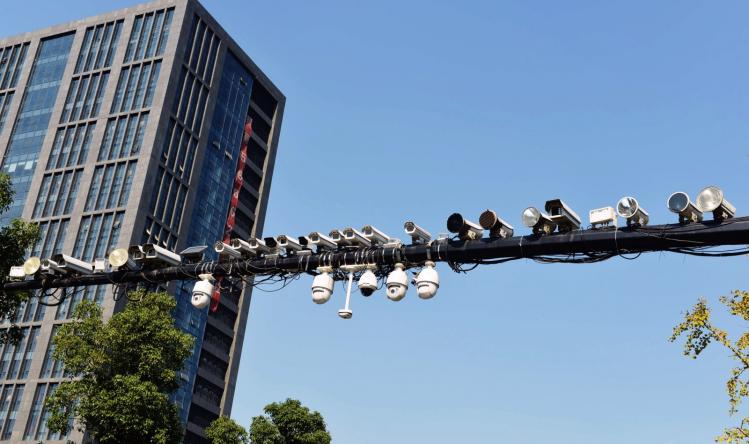
Every so often, I witness a scene in my neighborhood that’s all too common in New York City. A single car is double-parked on a narrow side street in front of a large apartment building. A blocked, frustrated driver—say, of a school bus full of frenetic children, or a delivery van on a tight schedule—angrily lays on the horn, sometimes for a full minute or more. Sometimes the guilty party sheepishly emerges to move their vehicle. But just as often they don’t.
If this were not Queens but Hangzhou, a city near China’s eastern coast, there would be no need for honking. In China’s “smart cities,” surveillance cameras immediately flag double-parked cars and run their plates to identify the owner. Local city managers, known as the Chengguan, then order such cars be moved via text message. Traffic can then resume flowing within minutes.
This is one positive element of China’s increasingly data-driven governance, analyzed by veteran reporters Josh Chin and Liza Lin in Surveillance State: Inside China’s Quest to Launch a New Era of Social Control. Their presentation can make Hangzhou seem like a paradise of efficiency, even to Americans skeptical of government control. Given China’s extensive record of human-rights violations, it can be tempting to dismiss innovations like Hangzhou’s camera and AI-based technology as tools of oppression. But, as Chin and Lin point out, the story is more complicated: surveillance technology in places like Hangzhou actually has improved the lives of some Chinese citizens. But it’s telling that “Datatopia,” Chin and Lin’s chapter on the benefits of surveillance in Hangzhou, is also the book’s shortest.
The rest of Surveillance State is devoted to cataloging and analyzing the ways in which Chinese authorities use facial recognition, social media and consumer data, biometrics, and a vast network of cameras to subdue and, in the case of China’s Uyghur population, persecute its people. The book opens by recounting the story of Uyghur poet and filmmaker Tahir Hamut. Hamut describes how his family was brought to a police station to have their faces analyzed, their blood drawn, and their irises scanned. As Hamut watches other men in his town gradually being rounded up and sent elsewhere, he begins to realize that the police were surveilling his family to make it easier to locate and arrest him. Hamut takes to laying out a set of clothes every night before bed, in case the police suddenly arrive to take him away. He also starts exploring ways to help his family escape China.
Such horrors, especially those committed against the Uyghurs in Xinjiang, have been well documented by journalists and academics. What Chin and Lin offer is a new perspective on the historical context of such surveillance. The Chinese Communist Party (CCP) is hardly the only state government to use technology for national-security purposes. Chin and Lin point out that in 2012, Barack Obama announced plans to harness big data. (The “Big Data Research and Development Initiative” invested $200 million across six federal agencies.) Where the CCP differs is in its profound belief in the capacity of technology to literally re-engineer society and re-program its people. This belief isn’t new. In its early days, the CCP used lower-tech methods such as extensive propaganda, forced indoctrination, and political campaigns like the Cultural Revolution; reeducation through labor wasn’t outlawed until 2013. (Xinjiang’s internment camps remain a glaring exception.)
As early as the mid-1950s, the CCP was already attempting to develop systems that could process large amounts of data in order to predict human behavior and solve societal problems. One of Surveillance State’s most fascinating chapters is “Man and Machine,” about the life and work of mathematician and physicist Qian Xuesen. Qian had been living in the United States for more than ten years, working at Caltech and on the Manhattan Project, when the CCP took over mainland China. After falling afoul of McCarthyism in 1950, Qian was kept under house arrest in his California home for five years. In 1955, the United States deported Qian and his family to China. Back in China, Qian helped create China’s nuclear-weapons program; he also delved deeper into cybernetics, the study of the relationship between information and control. Qian believed cybernetics could help reduce political corruption and resolve economic challenges. By 1989, Qian was arguing that “scientific development” needed to be more closely tied to social stability. Thirty years later, that is precisely what the CCP believes it is doing.
While Surveillance State does an excellent job unpacking the CCP’s philosophical commitment to surveillance, it also makes a few missteps. For one thing, it would have benefited from a more linear historical narrative—jumping back in time at the beginning of every chapter is confusing. More glaringly, “Partners in Pre-Crime,” a chapter that explores U.S. tech companies’ assistance in developing China’s surveillance state, is unpersuasive. Here the authors casually assert that “The Western business world…has midwifed the Party’s surveillance state since its embryonic beginnings in the late 1990s.” But Chin and Lin don’t provide compelling evidence of this. Most of their examples involve partnerships from the early 2000s, a time when both the United States and the United Kingdom engaged in even more surveillance than China. It’s true that companies like HP, Seagate, and Western Digital still sell hardware to Chinese companies, but that doesn’t make them co-creators of China’s surveillance state. Consider what happened in Hangzhou. The idea of a smart city, along with some of its early software, was first developed by IBM. Sensing a lucrative emerging market, in 2009 IBM representatives visited various Chinese cities to promote the concept. In Hangzhou, the China Electronics Technology Group Corporation was intrigued, and went on to build the centralized data platform that has improved Hangzhou residents’ quality of life—the same platform that the police now use to round up and unlawfully detain Uyghurs in Xinjiang. Should IBM be held responsible? And if so, how?
For its part, the U.S. government has begun placing restrictions on U.S. hardware making its way to China. In early October 2022 (right after Surveillance State’s publication), the U.S. government issued sweeping regulations that bar U.S. companies from selling high-end chips, tools, and talent to China. But the new rules fail to address the role that American venture capitalists and investors play in the development of China’s surveillance state. As recently as 2019, American investment funds, retirement systems, and universities were still pumping money into SenseTime and Megvii, two Chinese companies that provide technology to the Xinjiang police. As Chin and Lin more convincingly show, these investors can hardly claim ignorance. Two years earlier, SenseTime was proudly proclaiming its collaboration with China’s public security apparatus. The Biden administration is aware of the problem and has even discussed tightening the rules on such investments. But it has yet to issue any formal guidance, likely in order to avoid further escalation of diplomatic tensions with China.
As we continue to witness the expansion of artificial intelligence and surveillance technologies, how can we ensure that its use resembles what’s happening in Hangzhou and not in Xinjiang? As the CCP actively promotes its technology abroad, Western democracies are facing urgent questions about how to balance surveillance technology with human rights. At the moment, the United States appears paralyzed, with few laws, rules, or regulations governing surveillance and data-usage. It’s also concerning that, as Chin and Lin point out, most Americans seem alarmingly comfortable with state-sponsored surveillance and data collection. Thus, Muslim-Americans after September 11, far-right extremists after January 6, and Black Lives Matter protesters following the 2020 killing of George Floyd have all been targets of state surveillance—with little backlash from the American public. In these last two instances, police used facial-recognition technology to identify and sometimes charge individuals. Was this legitimate?
We should certainly be concerned about what is happening with surveillance technology in China. But even more important is what is—and isn’t—happening with such technology in the United States. The CCP has made its decision, and there’s little the United States can do to interrupt it. Sanctions and restrictions won’t accomplish much in the long run. As Surveillance State makes clear, what’s really needed is a coherent alternative, a values-based framework that directs each stop of technological progress toward bolstering human rights and advancing the common good. But until the United States confronts its own inner divisions and contradictions, that’s unlikely to happen.
Surveillance State
Inside China’s Quest to Launch a New Era of Social Control
Josh Chin & Liza Lin
St. Martin’s Press
$20 | 320 pp.
Please email comments to [email protected] and join the conversation on our Facebook page.
Share
Previous Story
More than Machines?
Next Story
The Civil Theology of Robert Bellah


